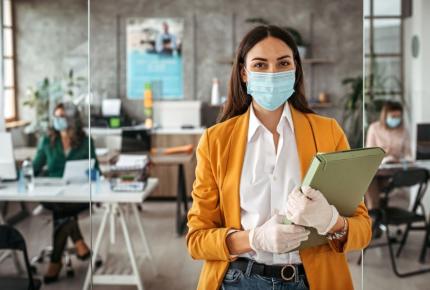
Is your workplace ready for the next infectious disease outbreak?
Few businesses implemented biosafety risk protocols before COVID-19. As employees increasingly return to the workplace, companies now need to adjust to a new “normal” to ensure preparedness for future outbreaks.
From Ebola and Zika to H1N1 and COVID-19, the world has witnessed several infectious disease outbreaks over the past decade. In fact, a landmark study1 showed that the number of emerging infectious diseases has grown steadily over the last 60 years, which has put a significant burden on global economies and public health.
According to the World Health Organization, the causes of this alarming pattern2 are numerous: a globalized economy, rapid urbanization, unprecedented population growth, climate change, our way of life, and air travel, among others. As a result, the world will need to increasingly prepare for when—not if—the next outbreak occurs.
The growing concern of exposure risk
Today, the current COVID-19 pandemic has made companies and employees acutely aware of the risk associated with an infectious disease outbreak in the workplace. For companies, this risk impacts not only business continuity, but also reputation and employee well-being. In fact, nearly one in two (41%) workers said they are afraid to go back to work because of the risk of exposure, according to a recent survey3.
It is statistics like these that prove the perception of health and safety in the workplace has greatly evolved. Employers now have the added responsibility of ensuring their employees can safely carry out their work even during a pandemic. Governments have introduced legislation to oblige employers to take the necessary preventative measures to protect their workforce, and in some countries employers can be considered criminally liable for workplace sanitary issues. In this context, it is even more important for them to demonstrate that they have taken all reasonable steps to protect their employees’ health.
Biosafety risk: the new “normal” in today’s workplace
Faced with this new reality, businesses now require a framework to help them better manage the risk of infection in the workplace. Putting in place a management system that focuses specifically on biosafety is a step in the right direction.
Bureau Veritas’ Biosafety Certification scheme is based on an infectious disease management system standard which requires a policy, implementation of best practice controls and sanitary protocols to meet regulatory advice and requirements and minimize contamination risk during an outbreak. Biosafety Certification assures that businesses have determined the most effective resources, employee competences and protection measures required to ensure compliance. These measures follow a hierarchy of controls, familiar to those with health and safety management systems: engineering and administrative controls, which focus on isolating people from and reducing exposure to hazards (i.e. air filters, physical barriers, teleworking, etc.). They can also include safe work practices that reduce frequency and exposure to hazards, as well as personal protective equipment (PPE) that can help prevent certain exposures.
Biosafety is a highly complex issue. An outbreak can happen at any time in the workplace, and while pre-defined protocols can substantially mitigate the risk, their effectiveness also depends upon employee awareness and behavior.
This is why the management system approach provides an optimum way for businesses to manage the risk of infectious disease outbreaks. It helps businesses monitor the risk, keep their employees informed and Biosafety Certification ensures the company’s commitment to a safe working environment is made known to the outside world.

